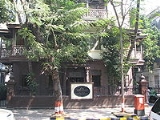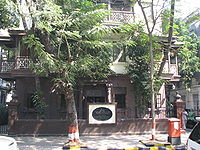
Mani Bhavan
Encyclopedia
Mani Bhavan, located at # 19, Laburnum Road in the Gamdevi precinct of downtown Mumbai
, acted as the focal point of Gandhi's political activities in Mumbai between 1917 and 1934.
 The mansion belonged to Revashankar Jagjeevan Jhaveri and the Mani family prior to that, Gandhi's friend and host in Mumbai during this period.
The mansion belonged to Revashankar Jagjeevan Jhaveri and the Mani family prior to that, Gandhi's friend and host in Mumbai during this period.
, Satyagraha
, Swadeshi
, Khadi
and Khilafat
movements. In 1955, the building was taken over by the Gandhi Smarak Nidhi
in order to maintain it as a memorial to Gandhi, to his frequent stays, and to the political activities he initiated from there.
The two-storeyed structure standing on the Laburnum Road is the city's pride. The building, which is about 40 minutes drive from Taj hotel, was Gandhi's Mumbai headquarters for about 17 years - from 1917-1934.
Gandhi's association with the charkha (Hindi for Spinning Wheel) began in 1917, while he was staying at Mani Bhavan.
Mani Bhavan is also closely associated with Gandhi's involvement in the Home Rule Movement
, as well as his decision to abstain from drinking cow's milk in order to protest the cruel and inhuman practice of phookan meted out to milch cattle common during that period.
The room that Gandhi used during his stay here is on the second floor - there is a glass partition and people can see through two of his spinning wheels, a book and floor bed still preserved. Right opposite the room there is a hall where photographs and paintings of his lifetime are on display.
And finally when one reaches the terrace where he was arrested on Jan 4, 1932.
became the first high-profile international visitor to visit the Mani Bhavan Gandhi Sangrahalaya in the last 50 years. The museum authorities say his visit brought attention to Mani Bhavan and are hoping for an increase in visitors. "It was only
Martin Luther King (US civil rights leader) who visited Mani Bhavan in the 1950s and as far as international personalities are concerned so far, it has only been Barack Obama in all these years who has come here after him," said Meghshyam T. Ajgaonkar, executive secretary of Mani Bhavan. The Mani Bhavan authorities gave two books to the President as gifts: "Women in Indian Society" co-authored by Usha Thakkar and Neera Desai and "Mahatma - Golden Treasury of Wisdom" which is a compilation of all of Gandhi's thoughts in various subjects given in alphabetical order. President Obama was also presented with two CDs - a two-and-half hour documentary on Mahatma Gandhi made by Vithalbhai Javeri, former trustee of Mani Bhawan and "Samar Geet", an audio CD of freedom songs sung by Shubha Mudgal. Obama gave a book authored by him to the Museum library.
Mumbai
Mumbai , formerly known as Bombay in English, is the capital of the Indian state of Maharashtra. It is the most populous city in India, and the fourth most populous city in the world, with a total metropolitan area population of approximately 20.5 million...
, acted as the focal point of Gandhi's political activities in Mumbai between 1917 and 1934.

Gandhi's Headquarters
It was from Mani Bhavan that Gandhi initiated the Non-CooperationNon-cooperation movement
The non-cooperation movement was a significant phase of the Indian struggle for freedom from British rule which lasted for years. This movement, which lasted from September 1920 to February 1922 and was led by Mohandas Gandhi, and supported by the Indian National Congress. It aimed to resist...
, Satyagraha
Satyagraha
Satyagraha , loosely translated as "insistence on truth satya agraha soul force" or "truth force" is a particular philosophy and practice within the broader overall category generally known as nonviolent resistance or civil resistance. The term "satyagraha" was conceived and developed by Mahatma...
, Swadeshi
Swadeshi movement
The Swadeshi movement, part of the Indian independence movement, was an economic strategy aimed at removing the British Empire from power and improving economic conditions in India by following the principles of swadeshi , which had some success...
, Khadi
Khadi
The term khādī or khaddar means cotton. khādī is Indian handspun and hand-woven cloth. The raw materials may be cotton, silk, or wool, which are spun into threads on a spinning wheel called a charkha. It is a versatile fabric, cool in the summer and warm in the winter...
and Khilafat
Khilafat Movement
The Khilafat movement was a pan-Islamic, political campaign launched by Muslims in British India to influence the British government and to protect the Ottoman Empire during the aftermath of World War I...
movements. In 1955, the building was taken over by the Gandhi Smarak Nidhi
Gandhi Smarak Nidhi
The National Gandhi Memorial Trust also called the Gandhi Qaumi Yaadgar Fund, is a memorial trust run by the Central Government of India established to commemorate the life of Mahatma Gandhi...
in order to maintain it as a memorial to Gandhi, to his frequent stays, and to the political activities he initiated from there.
The two-storeyed structure standing on the Laburnum Road is the city's pride. The building, which is about 40 minutes drive from Taj hotel, was Gandhi's Mumbai headquarters for about 17 years - from 1917-1934.
Gandhi's association with the charkha (Hindi for Spinning Wheel) began in 1917, while he was staying at Mani Bhavan.
Mani Bhavan is also closely associated with Gandhi's involvement in the Home Rule Movement
Home Rule Movement
The All India Home Rule League was a national political organization founded in 1916 to lead the national demand for self-government, termed Home Rule, and to obtain the status of a Dominion within the British Empire as enjoyed by Australia, Canada, South Africa, New Zealand and Newfoundland at the...
, as well as his decision to abstain from drinking cow's milk in order to protest the cruel and inhuman practice of phookan meted out to milch cattle common during that period.
Gandhi's Museum & Library
Once you enter the place, there is a library with statue of the Mahatma where people offer their tributes. Then a staircase dotted with Gandhi's pictures depicting his life leads visitors to the first floor which has big photo gallery where photographs of his childhood till his assassination are displayed along with press clippings.The room that Gandhi used during his stay here is on the second floor - there is a glass partition and people can see through two of his spinning wheels, a book and floor bed still preserved. Right opposite the room there is a hall where photographs and paintings of his lifetime are on display.
And finally when one reaches the terrace where he was arrested on Jan 4, 1932.
Obama's Visit
In his November 2010 visit, Barack ObamaBarack Obama
Barack Hussein Obama II is the 44th and current President of the United States. He is the first African American to hold the office. Obama previously served as a United States Senator from Illinois, from January 2005 until he resigned following his victory in the 2008 presidential election.Born in...
became the first high-profile international visitor to visit the Mani Bhavan Gandhi Sangrahalaya in the last 50 years. The museum authorities say his visit brought attention to Mani Bhavan and are hoping for an increase in visitors. "It was only
Martin Luther King (US civil rights leader) who visited Mani Bhavan in the 1950s and as far as international personalities are concerned so far, it has only been Barack Obama in all these years who has come here after him," said Meghshyam T. Ajgaonkar, executive secretary of Mani Bhavan. The Mani Bhavan authorities gave two books to the President as gifts: "Women in Indian Society" co-authored by Usha Thakkar and Neera Desai and "Mahatma - Golden Treasury of Wisdom" which is a compilation of all of Gandhi's thoughts in various subjects given in alphabetical order. President Obama was also presented with two CDs - a two-and-half hour documentary on Mahatma Gandhi made by Vithalbhai Javeri, former trustee of Mani Bhawan and "Samar Geet", an audio CD of freedom songs sung by Shubha Mudgal. Obama gave a book authored by him to the Museum library.
See also
- Non-Cooperation MovementNon-cooperation movementThe non-cooperation movement was a significant phase of the Indian struggle for freedom from British rule which lasted for years. This movement, which lasted from September 1920 to February 1922 and was led by Mohandas Gandhi, and supported by the Indian National Congress. It aimed to resist...
- KhadiKhadiThe term khādī or khaddar means cotton. khādī is Indian handspun and hand-woven cloth. The raw materials may be cotton, silk, or wool, which are spun into threads on a spinning wheel called a charkha. It is a versatile fabric, cool in the summer and warm in the winter...
- SatyagrahaSatyagrahaSatyagraha , loosely translated as "insistence on truth satya agraha soul force" or "truth force" is a particular philosophy and practice within the broader overall category generally known as nonviolent resistance or civil resistance. The term "satyagraha" was conceived and developed by Mahatma...
- Swadeshi
- Charkha
- Khilafat MovementKhilafat MovementThe Khilafat movement was a pan-Islamic, political campaign launched by Muslims in British India to influence the British government and to protect the Ottoman Empire during the aftermath of World War I...

